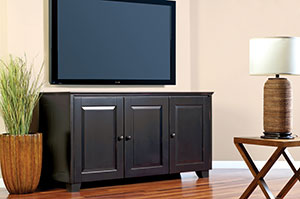Furniture For AV Pros
In the world of retail, the furniture business and the electronics business have been interwoven  for a long time. While furniture stores often sell electronics these days and electronics stores sell furniture, the fact is that the latter seldom get as big a piece of the furniture pie as they ought to.
for a long time. While furniture stores often sell electronics these days and electronics stores sell furniture, the fact is that the latter seldom get as big a piece of the furniture pie as they ought to.
There are two main reasons for that. The first is that there’s a perception that the furniture sold at electronics retailers is low end junk. The second is that, for some AV retailers both large and small there’s a comfort-zone issue, and managers just don’t “get” the furniture business. As a result, they leave money on the table when dealing with their clients.
To address the first point, while the cheap chipboard and black-vinyl wrapped TV stands that are often offered as “Free Stand” promos on sale weekends and shoddy ready-to-assemble entertainment consoles are present at big-box chains, specialty AV retailers can offer their customers furniture choices that are both aesthetically attractive, as well as offering fantastic margins to the dealer.
Margin. We all want it, and sad to say precious few categories deliver it in the AV world anymore; all the more reason to get out of your comfort zone and seriously consider a product that delivers 50-70 points.
Offering furniture is simple: People who are shopping for electronics need something to put their equipment in, and they need something to sit on while using them. They’re going to spend that money anyway, so do your best to make them spend it with you!
If it’s such a great idea, why don’t AV retailers sell more furniture? In general, the big divide between furniture and AV retailers and the AV dealer’s barrier is that furniture dealers have the luxury of more selection and more styles displayed on the floor.
That challenge means that AV dealers need to seek solutions. Part of the solution is to find the key pieces to carry that will work for your customers. Building on that, you need to leverage your website, and the color swatches of the pieces that you do display in your showroom and offer more selection than you can realistically display in your showroom.
If your clients are leaving without buying furniture, it’s because of what you’re carrying, or more specifically, what you’re not carrying. While it’s tempting to stick with what you probably consider “safe”: black and stainless steel, customers want furniture that’s daring and interesting.
Further to breaking out of that mold is to reject the preconception that at an AV retailer people are buying furniture based on low price points. For their part, AV retailers themselves see furniture as more of an afterthought of an attachment, rather than a complimentary piece of equipment, the way a Blu-ray player goes with a flat panel TV.
Part of the solution is for dealers to see furniture as more of a centerpiece than just something that a TV needs to go on, and present it that way to customers.
With regard to what’s trendy and exciting in furniture, it’s understandable that TV size has had a major impact on furniture demand. Many consumers who already have a large screen in the main room are taking advantage of low TV pricing to buy a smaller second TV for bedrooms and other secondary areas, which is driving demand for appropriate TV stands to put them on.
At the same time, TVs are getting both larger and cheaper, and furniture that can accommodate a 60-inch or larger flat panel are in demand. Not everyone who purchases a 70 or 80-inch flat panel is going to wall mount it, but even if they do, they still require furniture to house the source components, and those pieces have to be scaled appropriately to not look out of place with the giant screen.
If you’ve been paying attention to AV furniture at all in recent years at CES and elsewhere (and if you haven’t, don’t worry; that’s what I’m here for), there have been a couple of major trends, both of which work to help AV dealers differentiate themselves.
The first has been the trend of bringing high quality to middle price points. Quite a few brands of AV furniture no offer great looking selections that only cost hundreds, as opposed to thousands of dollars.
The second is the growth of offerings that make use of sustainable materials. Green initiatives emphasize environmentally responsible manufacturing. And furniture products are made of sustainable materials, including woods that are harvested from managed forestry programs, and composite materials that comply with rigorous certification standards combined with environmentally friendly coatings and finishes that meet or exceed the most stringent air quality standards give dealers further selling points with their clients.
Next time I’ll expand further on what to look for and how to position furniture in your lineup.
Lee Distad is a rAVe columnist and freelance writer covering topics from CE to global business and finance in both print and online. Reach him at lee@ravepubs.com





